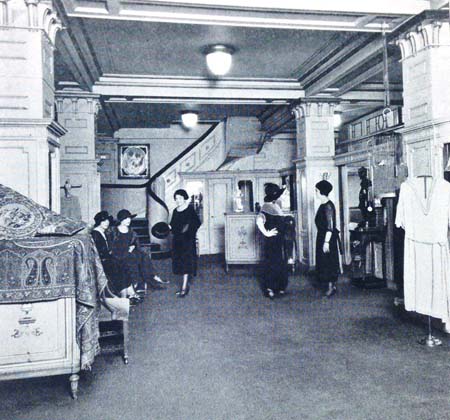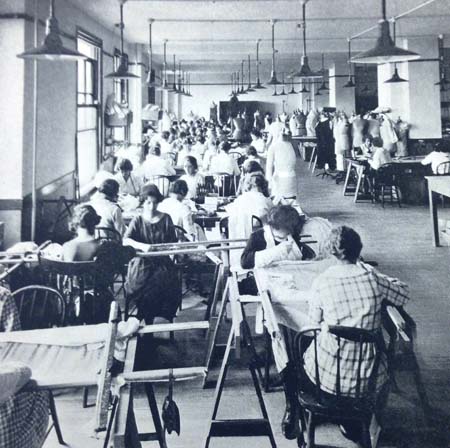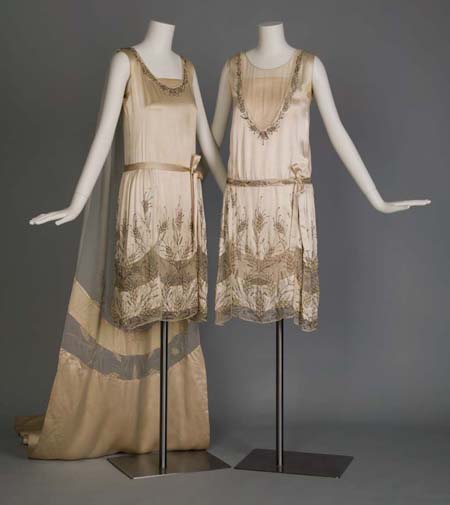In honor of Chicago Styled: Fashioning The Magnificent Mile®, the Museum blog will publish a series of posts highlighting the stores, garments, designers, donors, and urban developments featured in the exhibition.
“The woman who is clever is not a slavish follower of style. She never clings blindly to an arbitrarily prescribed fashion. Individuality is a much more important result to strive for than mere newness.” —Harry H. Blum, Within the Portals
Blum’s Vogue was a specialty department store founded by Harry and Becky Blum in Chicago in 1910. The original store was simply called Blum’s and was located in the Congress Hotel, then home to Sarah Bernhardt, Ethel Barrymore, and other famous theatrical stars of the day. Blum’s quickly became successful, and shortly thereafter the Blums opened a second store, Vogue, a few doors down. While Blum’s sold ready-to-wear clothes, Vogue sold custom-made garments. In 1924, the Blums bought their own building at 624 South Michigan Avenue and began extensive renovations. Finally, in 1930, they moved to their new premises and combined their two stores into one: Blum’s Vogue. The store was enormously successful, expanding to several locations in Chicago and eventually nationwide. It wasn’t until 1983 when the last store in the chain finally closed.
In 1923, Blum’s and Vogue released Within the Portals, a promotional booklet written by Harry Blum. It offered a behind-the-scenes look at how garments were either bought or designed, constructed, and sold to the women of Chicago. Moreover, it expounded on the guiding philosophies of the company. Because of this, Within the Portals is a valuable resource documenting retail practices in the early 1920s and provides a glimpse into Chicago’s development into an important location for fashion.

The Vogue shop as pictured in Within the Portals.
Throughout Within the Portals, Blum emphasized the importance of giving his customers a personalized shopping experience—his stores were advertised as operating like a couturier instead of a normal department store, allowing women access to exclusive and custom designs tailored to their individual needs.

A photograph in Within the Portals of one of the dressmaking studios.
Unlike department stores today, garments were not merely purchased from design houses and then sold as-is to the customer. One of the advertised benefits of shopping at Blum’s and Vogue was that women had the opportunity to customize their purchase. Blum writes, “Very often we urge a client to accept an American adaptation of some foreign style because foreign models are not becoming to all women. In fact, most American women require that the exaggerations which are accepted abroad without protest, be interpreted to harmonize with the personality of the wearer.” This quote reveals two important details. Firstly, that the tailor considered the customer’s personality when customizing a dress, showing that women were eager to develop their own individual style. Secondly, Blum’s and Vogue made a concerted effort to not just copy European fashions, but to develop a truly American style of dress for American women. In details such as these, we can see how Chicago’s own unique sense of style was developed.

Left: Wedding dress, Blum’s Vogue, Chicago, X1076ab; right: Wedding dress, Gift of Mrs. Gardner H. Stern*, 1977.28.1. CHM, ICHi-054646
This type of customization is illustrated by these two wedding gowns (both from 1927) in the Museum’s collection. While the dresses have the same overall design, modifications have been made for the individual wearers. Mrs. Stern’s dress on the right has more complex neckline than the dress on the right and extra beading on the ribbon at the waistline. It is rare for a collection to have objects such as these dresses, purchased at the same store and of the same overall design but slightly altered for each individual owner. Through books such as Within the Portals and dresses such as these, we are able to gain a uniquely detailed glimpse at a particular moment in Chicago’s fashion history.
*Mrs. Gardner H. Stern was the second president of the Museum’s Costume Council.
Join the Discussion